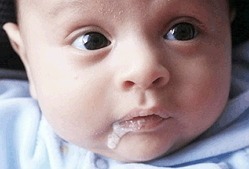Pylorospasm
 Pylorospasm is a pathological condition that manifests itself in childhood. Characterized pylorospasm vegetative dystonia in sympathetic type due to not fully matured nervous system, it is often cured independently. At the base of the pylorospasm lies the spasmodic area at the site of the antral section of the stomach into the duodenum. As a result, there is a difficult movement of food through this site and its stagnation. With the duration of flow and neglect, the process is transformed into a difficult stage. As a result, the structure of the mucosa changes toward atrophy and a condition develops requiring urgent intervention by the surgeon.
Pylorospasm is a pathological condition that manifests itself in childhood. Characterized pylorospasm vegetative dystonia in sympathetic type due to not fully matured nervous system, it is often cured independently. At the base of the pylorospasm lies the spasmodic area at the site of the antral section of the stomach into the duodenum. As a result, there is a difficult movement of food through this site and its stagnation. With the duration of flow and neglect, the process is transformed into a difficult stage. As a result, the structure of the mucosa changes toward atrophy and a condition develops requiring urgent intervention by the surgeon.
Causes of pylorospasm
The primary and secondary pilorospasm are distinguished by the time and conditions of the onset of the disease.
Primary pilorospasm arises as a primary disease under the influence of a number of the following unfavorable causes:
- in case of malfunctioning of the central nervous system, the nervous regulation of the entire stomach and its pyloric section are disrupted;
- if the autonomic nervous system is disturbed, an increase in the tone of the vagus nerve is noted, which also causes a disturbance in the nervous regulation of the stomach;
- for various intoxications( nicotine, morphine);
- with a lack of certain vitamins and trace elements( B vitamins);
- less often with severe fatigue( physical or mental), stressful situations.
Secondary pilorospasm occurs against the background of other diseases and conditions:
- with stomach ulcer( ulcer in the pyloric region) and gastritis( more often chronic);
- with inflammation in the initial parts of the small intestine( duodenitis);
- with stomach polyps;
- for diseases of the biliary tract( cholecystitis, cholelithiasis, etc.);
- with intestinal diseases( colitis, Crohn's disease);
- in the formation of intestinal adhesions in the postoperative period.
Smoking, some medicines, exposure to chemicals in some cases can also be provoking factors of pylorospasm.
Pylorospasm in a newborn is clinically uncommon, as it usually takes 2-3 weeks before the clinical manifestation of the disease. The exception is the case of severe labor and severe disruption of the central nervous system: with encephalopathy of posthypoxic or mixed genesis, hypertensive or hypertensive-hydrocephalic syndrome.
Pylorospasm in infants is a common problem and it occurs as a consequence of prolonged hypoxia in childbirth, immaturity of the nervous system, in the syndrome of neural-reflex hyperexcitability. Characterized by self-healing after a while( the need is only in palliative care).
Symptoms of pilorospasm
Symptoms of pilorospasm depend on the stage of the disease. When the stage is compensated, the food is stressed, but it is pushed through the narrowed hole. Classically this form is manifested by a feeling of heaviness of the subcostal area and nausea. But there may be colicky pains in the zone of the stomach( the region of the left hypochondrium and in the epigastrium), in rare cases vomiting. After a bout of pain, a large amount of urine of light color with a low specific gravity( "urinary crisis") is released.
In the stage of decompensation of the pilorospasm of a man, frequent paroxysmal pains in the stomach are suffered. The permeability of the gastric outlet is completely impaired. Eating is accompanied by vomiting, which brings short-term relief( while vomit can be stagnant with an unpleasant odor).It can be "vomiting a fountain", usually when the stomach is hypersecreted with hydrochloric acid. Because of frequent vomiting, a person's condition worsens: weakness, weight loss, insomnia. With vomit, water and salt are eliminated from the body, leading to dehydration and depletion. In this case, it is necessary to think about the transition of pylorospasm to the chronic stage.
Pylorospasm in infants appears on the 2-3 week of life and its clinical picture is quite typical. At first the child begins to regurgitate frequently, becomes restless. Then there is a "vomiting of a fountain".It is frequent, worries after feeding and even after 1-2 hours, is characterized by a small amount of vomit without bile, with the acidic smell of curdled milk. There is a delay in weight gain. In difficult cases, constipation may be disturbed, urination becomes less frequent. The child is restless, capricious, does not sleep well. Frequent colic may be accompanied by crying. With a long course of blood levels change: the level of hemoglobin decreases, and then of potassium and chlorine, which gradually leads to dehydration.
When palpating the abdomen, a dense formation in the epigastric region can be palpated. In rare, neglected cases of pylorospasm in children( especially depleted), it can be manifested by the so-called "hourglass" symptom: the visible peristalsis of the stomach, usually one or two hours after a meal.
Diagnosis of pilorospasm
Diagnostics of pilorospasm begins with the collection of anamnesis. It is necessary to clarify whether there are chronic diseases in humans. If not, then whether the pains in the abdomen, whether there is a nausea, vomiting. It is also worth asking whether surgery was performed on the abdominal cavity( suspicion of an adhesion process).In the case of pyloric stenosis in children, it is necessary to clarify with the parents how the pregnancy took place: whether there were factors in the development of encephalopathy, fetal hypoxia, whether there were threats of miscarriage.
It is necessary to take into account the clinical picture. Nausea, pain and vomiting are not pathognomonic for pilorospasm. But the possibility of having this disease must always be remembered. The only specific symptom of pilorospasm is "vomiting fountain", but it manifests itself more often in children.
The blood test and urinalysis, being laboratory methods, are not so informative. In the lungs and uncomplicated cases of pylorospasm they are not changed. In severe, decompensated conditions, anemia, hypokalemia, chloremia is noted. Urine of light color, with a low specific gravity.
The basis for diagnosing pilorospasm are instrumental methods: X-ray examination of the intestine with contrast material and fibro-eso gastroduodenoscopy. At a roentgenological examination, a contrast agent( barium sulfate) is administered. Children are given barium sulfate, mixed with breast milk or milk formula. On the X-ray, the food is delayed, while the barium suspension enters the intestine in small portions. The stomach can be changed in shape. In this study, it is necessary to introduce antispasmodics( usually atropine sulfate solution).In the case of pilorospasm, the spasm will go away and the contrast will pass without delays into the intestine. This radiological picture is more likely for a severe form of pylorospasm, when there is concomitant muscle hypotrophy of the output stomach. In the case of light forms, the permeability will not be disturbed, and gastric emptying from the contrast will occur in 3-4 hours.
Additionally, endoscopy is performed. The oval form of the pylorus is revealed, the endoscope freely passes through its opening. The stomach is free. Insufflate with air, while the gatekeeper slowly opens. This, too, speaks in favor of pylorospasm. In severe cases, the stomach will be digested food, the gatekeeper is spasmodic, but passable. Morphological changes will be absent.
In rare cases, ultrasound of the stomach is performed, in which no changes in the pylorus are detected.
Due to the fact that the symptoms of pilorospasm are not specific, it is extremely important to conduct a comparative diagnosis with a number of similar diseases. First of all with pyloric stenosis. It is characterized by "vomiting fountain" from two weeks of age, constipation, rapid deterioration of the condition. Changes in blood and urine tests. On the roentgenogram, the gatekeeper is closed for a long time, the pyloric department in the form of a thin thread. Spasmolytic substances do not change the picture. With endoscopy, morphological changes in the walls of the gastric outlet are visible, and muscle hypertrophy.
Pylorospasm in children is also differentiated with hernia of the esophagus of the diaphragm and achalasia of the cardia. In all cases, the radiologic examination is decisive. In adults, comparative diagnosis is carried out with diseases of the intestine: peptic ulcer, gastritis, cholelithiasis, cholecystitis, colitis and others.
Treatment of pilorospasm
The main thing in the treatment of pilorospasm should be getting rid of the cause of the disease. If this is a secondary pylorospasm, then the underlying disease is treated. If this vegetative dystonia is sympathetic, then sedative therapy is prescribed. The basis of treatment is nutrition and antispasmodic substances.
Pylorospasm in infants in the lungs, unopened cases does not need a special diet. A calm, friendly atmosphere is needed. The volume of food and the frequency of feeding does not change. Recommend thick porridge and 1-2 teaspoons of alkaline mineral water before eating. In severe cases, frequent fractional feeding is prescribed. If it is breastfeeding, then often applying to the chest. If this is artificial feeding, then mixtures with thickeners( Frisov, Nutrolon, Semper-Lemolak, Enfamil-AR, Bellakt-AR) are recommended. The composition of these mixtures includes locust bean gum, which increases the viscosity of the contents of the stomach, which significantly reduces the amount of vomiting. In addition, it stimulates intestinal peristalsis, which helps in the fight against colic. After feeding the baby, you need to wear a "pillar" on your hands for half an hour and then spread it on your stomach.
Adults are prescribed a diet with the use of mechanically and chemically sparing food. It is recommended to use puree food in a warm form, preferably porridge. The use of any kinds of spicy, salty, sour food is restricted. Smoking and alcohol are excluded. Need to eat often and in small portions.
Drug therapy pililospazma apply:
- myotropic antispasmodics - 0,04-0,08 g Papaverine hydrochloride or Drotaverine 3 r / day for adults( or 2% rp of these drugs intramuscularly 2 ml);
- muscle relaxants( m-cholinolytics) - 0.1% r. Atropine sulfate 1-2 drops 3 r / day or 0.2% r.p. Platifillina hydroaratate 1-2 ml per day;
- blockers of H1 - histamine receptors - 1-2 drops of 2.5% Prometazine( Pipolphen) before meals to children or 0.2 ml 0.5% Promethazine IM;
- Neuroleptics - 0,002 g Chlorpromazine 3 r / day inside;
- vitamins of group B - Thiamine 10-15 mg per day intramuscularly 10 days;
- sedatives - Valerian in drops, Motherwort.
For severe vomiting, infusion therapy is performed: administration of 10% glucose solution( 500-1500 ml), isotonic 0.9% sodium chloride solution( about 500 ml) is prescribed. In addition, according to the indications, add 10% of potassium chloride( 20 ml) and insulin 1-2 units per 5-10 grams of glucose.
Physiotherapy with pilorospasm is an important part of an integrated approach, as it helps to relieve muscle spasms. Apply electrophoresis of antispasmodics( Papaverina or Drotaverina) in the area of the epigastrium for 5 to 10 sessions or Novocaine electrophoresis for 5-10 sessions. Also apply ozokerite, paraffin for 5-10 sessions a day.
Pylorospasm prognosis is generally good, but depends on the causes of the disease. If this is the primary pylorospasm( occurring most often in children), then under certain conditions and the correct mode of the day and nutrition, the disease is cured independently. If this is secondary pylorospasm( in adults), then everything depends on the disease that caused pylorospasm and cure this disease. Very often, the symptoms of pilorospasm at the initial stage are taken for errors in nutrition, for functional dyspepsia. In toga, the disease passes into a chronic stage with morphological changes in the pyloric zone of the stomach. In this case, treatment is only prompt, and even with a successful operation, the forecast is rather unfavorable.



